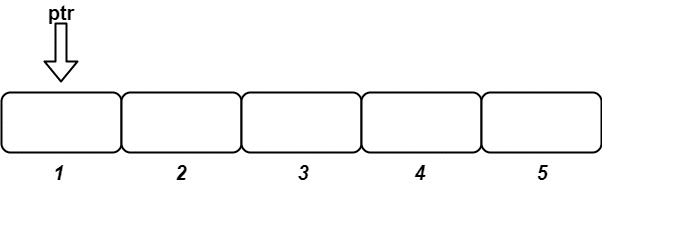原文链接: https://leetcode-cn.com/problems/design-an-ordered-stream
英文原文
There is a stream of n (idKey, value) pairs arriving in an arbitrary order, where idKey is an integer between 1 and n and value is a string. No two pairs have the same id.
Design a stream that returns the values in increasing order of their IDs by returning a chunk (list) of values after each insertion. The concatenation of all the chunks should result in a list of the sorted values.
Implement the OrderedStream class:
OrderedStream(int n)Constructs the stream to takenvalues.String[] insert(int idKey, String value)Inserts the pair(idKey, value)into the stream, then returns the largest possible chunk of currently inserted values that appear next in the order.
Example:

Input ["OrderedStream", "insert", "insert", "insert", "insert", "insert"] [[5], [3, "ccccc"], [1, "aaaaa"], [2, "bbbbb"], [5, "eeeee"], [4, "ddddd"]] Output [null, [], ["aaaaa"], ["bbbbb", "ccccc"], [], ["ddddd", "eeeee"]] Explanation // Note that the values ordered by ID is ["aaaaa", "bbbbb", "ccccc", "ddddd", "eeeee"]. OrderedStream os = new OrderedStream(5); os.insert(3, "ccccc"); // Inserts (3, "ccccc"), returns []. os.insert(1, "aaaaa"); // Inserts (1, "aaaaa"), returns ["aaaaa"]. os.insert(2, "bbbbb"); // Inserts (2, "bbbbb"), returns ["bbbbb", "ccccc"]. os.insert(5, "eeeee"); // Inserts (5, "eeeee"), returns []. os.insert(4, "ddddd"); // Inserts (4, "ddddd"), returns ["ddddd", "eeeee"]. // Concatentating all the chunks returned: // [] + ["aaaaa"] + ["bbbbb", "ccccc"] + [] + ["ddddd", "eeeee"] = ["aaaaa", "bbbbb", "ccccc", "ddddd", "eeeee"] // The resulting order is the same as the order above.
Constraints:
1 <= n <= 10001 <= id <= nvalue.length == 5valueconsists only of lowercase letters.- Each call to
insertwill have a uniqueid. - Exactly
ncalls will be made toinsert.
中文题目
有 n 个 (id, value) 对,其中 id 是 1 到 n 之间的一个整数,value 是一个字符串。不存在 id 相同的两个 (id, value) 对。
设计一个流,以 任意 顺序获取 n 个 (id, value) 对,并在多次调用时 按 id 递增的顺序 返回一些值。
实现 OrderedStream 类:
OrderedStream(int n)构造一个能接收n个值的流,并将当前指针ptr设为1。String[] insert(int id, String value)向流中存储新的(id, value)对。存储后:- 如果流存储有
id = ptr的(id, value)对,则找出从id = ptr开始的 最长 id 连续递增序列 ,并 按顺序 返回与这些 id 关联的值的列表。然后,将ptr更新为最后那个id + 1。 -
否则,返回一个空列表。
- 如果流存储有
示例:

输入 ["OrderedStream", "insert", "insert", "insert", "insert", "insert"] [[5], [3, "ccccc"], [1, "aaaaa"], [2, "bbbbb"], [5, "eeeee"], [4, "ddddd"]] 输出 [null, [], ["aaaaa"], ["bbbbb", "ccccc"], [], ["ddddd", "eeeee"]] 解释 OrderedStream os= new OrderedStream(5); os.insert(3, "ccccc"); // 插入 (3, "ccccc"),返回 [] os.insert(1, "aaaaa"); // 插入 (1, "aaaaa"),返回 ["aaaaa"] os.insert(2, "bbbbb"); // 插入 (2, "bbbbb"),返回 ["bbbbb", "ccccc"] os.insert(5, "eeeee"); // 插入 (5, "eeeee"),返回 [] os.insert(4, "ddddd"); // 插入 (4, "ddddd"),返回 ["ddddd", "eeeee"]
提示:
1 <= n <= 10001 <= id <= nvalue.length == 5value仅由小写字母组成- 每次调用
insert都会使用一个唯一的id - 恰好调用
n次insert
通过代码
高赞题解
解题思路
此处撰写解题思路
代码
class OrderedStream {
String[] a;
int i=0;
public OrderedStream(int n) {
a=new String[n];
for(int i=0;i<n;i++){
a[i] = "i";
}
}
public List<String> insert(int idKey, String value) {
List<String> list = new ArrayList<>();
if(i != idKey-1){
a[idKey-1] = value;
return new ArrayList<String>();
}else{
a[idKey-1]=value;
for(int j=idKey-1;j<a.length;j++){
if(a[j].equals("i")){
i=j;
break;
}
list.add(a[j]);
}
return list;
}
}
}
/**
* Your OrderedStream object will be instantiated and called as such:
* OrderedStream obj = new OrderedStream(n);
* List<String> param_1 = obj.insert(idKey,value);
*/统计信息
| 通过次数 | 提交次数 | AC比率 |
|---|---|---|
| 8219 | 10511 | 78.2% |
提交历史
| 提交时间 | 提交结果 | 执行时间 | 内存消耗 | 语言 |
|---|




